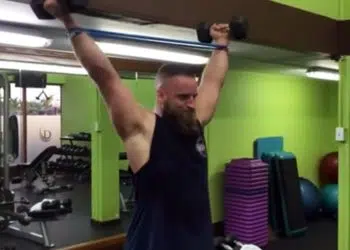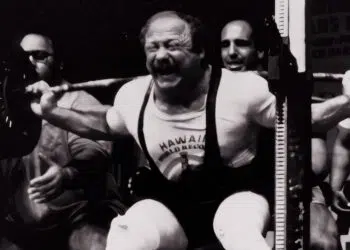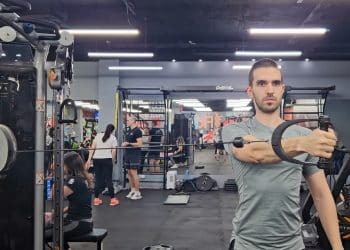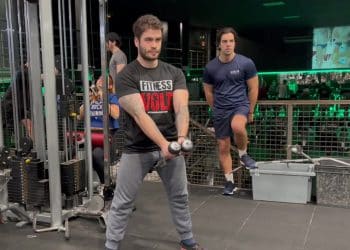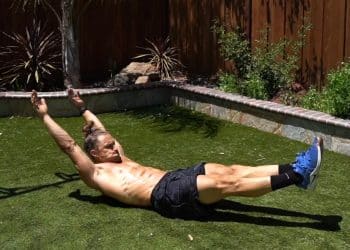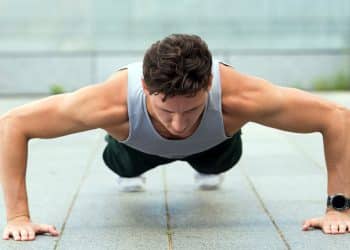Many of life’s most strenuous activities happen on one leg. Running, jumping, lifting, and kicking are all great examples. And yet, some exercisers have very few single-leg movements in their workout.
This is a mistake!
As a personal trainer with over three decades of experience, I understand the value of single-leg training and prescribe it to almost all of my PT clients. I have found that single-leg exercises enhance functionality while warding off injuries. It’s also one of the best ways to build a better butt!
And speaking of butts, the most effective way to target the glutes and posterior chain is with hip hinge exercises. These include variations of the deadlift, Romanian deadlift, and good morning. Studies on PubMed tell us that Posterior chain exercises can help improve athletic performance and build a healthier, stronger lower back (1, 2).
The single-leg good morning is a challenging hip hinge exercise I reserve for my more advanced clients. However, if you are up to it, it’s also one of the best ways to build strength and balance simultaneously.
In this article, I reveal why and how to do this unique exercise and provide several equally effective variations.
Level Up Your Fitness: Join our 💪 strong community in Fitness Volt Newsletter. Get daily inspiration, expert-backed workouts, nutrition tips, the latest in strength sports, and the support you need to reach your goals. Subscribe for free!
Single-Leg Good Mornings: Correct Form and Execution
Don’t undermine your progress or increase your risk of injury with poor exercise technique! Follow these steps to make sure that every rep of single-leg good mornings that you perform is as safe and effective as possible.
- Stand with your feet together, knees slightly bent. Rack and hold a barbell on your trapezius muscle. Brace your core and pull your shoulders down and back.
- Shift your weight over onto one leg.
- Hinge from the hips and lean forward as far as you can without rounding your lower back.
- Extend your other leg out behind you to act as a counterbalance.
- Return to the upright position, lowering your other leg as you come back up.
- Continue for the desired number of reps.
- Rest a moment and then repeat on the other side.
Muscles Worked
Single-leg good mornings involve several large, important muscles. Conversely, there are plenty of smaller, lesser muscles working, too. The main muscles developed by this exercise are:
- Gluteus maximus
- Hamstrings
- Hip abductors
- Hip adductors
- Erector spinae
- Core
Pro-Trainer Tips
Get more from single-leg good mornings with my tried-and-tested pro-trainer tips.
- Keep your chest up and lower back slightly arched to stabilize your pelvis and reduce the stress on your lumbar spine.
- Lean as far forward as you can without rounding your lower back. The deeper the stretch, the more effective this exercise becomes.
- Keep your eyes fixed on an immovable object. This will help you maintain your balance.
- Think about planting and spreading your supporting foot to enhance your balance.
- This exercise works best when done with light to moderate weights for medium to high reps. It does not work well with heavy loads and low reps.
Mistakes to Avoid
Make single-leg good mornings as safe as possible by avoiding these common mistakes.
- Rounding your lower back. Doing so increases the stress on your intervertebral disks and ligaments and could result in injury.
- Do not raise your head. Lifting your head, e.g., to look at yourself in a mirror, puts a lot of unwanted stress on your neck, so don’t do it!
- Keeping your knee straight. Slightly bend your supporting knee to take stress off your joints and increase muscle engagement.
- Relaxing your core. Keep your core braced throughout. This ensures your spine is supported for the entirety of your set.
- Resting the barbell on your neck. The bar should rest on your upper traps, below C7, which is the prominent vertebrae you can feel at the top of your spine.
Benefits
Not sure if single-leg good mornings deserve a place in your workouts? Consider these benefits and then decide.
- Better balance: Balance is your ability to keep your weight over your base of support. It’s a critical factor in most sports, as well as many activities of daily living. Balance declines with age and lack of use. Doing single-leg good mornings will improve your ability to maintain balance
- Improved flexibility: Leaning forward from your hips stretches your hamstrings. Doing this exercise regularly will enhance flexibility. I don’t do much flexibility training, but my hammies are still pretty loose. This is because I perform this exercise a couple of times a week.
- Identify and fix muscle imbalances: While I love the regular good morning, it can disguise and cause left-to-right strength imbalances. Training one leg at a time is the best way to identify and fix any such strength discrepancies.
- Improved functionality: Whether you are an athlete or just an active human being, you probably spend at least a little time on one leg. Therefore, if you want to get better at unilateral (single-legged) activities, you should include unilateral exercises in your workouts. Single-leg good mornings would be an excellent choice for improving functionality.
- Less lower back stress: Single-leg good mornings are much more challenging than the conventional version. Subsequently, you won’t be able to use as much weight. As such, they’re much easier on your lower back and ideal for those with back pain or fatigued back muscles. That said, you still need to avoid rounding your lower back to reduce your risk of injury.
Programming
Like most unilateral or single-leg exercises, single-leg good mornings are not really suitable for heavy weights and low reps. Instead, they work best with light to moderate weights and medium to high reps. 2-4 sets of 8-12 reps is a good option for most, but you can go as high as 20-30 reps if you prefer to train with light weights.
Level Up Your Fitness: Join our 💪 strong community in Fitness Volt Newsletter. Get daily inspiration, expert-backed workouts, nutrition tips, the latest in strength sports, and the support you need to reach your goals. Subscribe for free!
Gradually increase your weights or reps as you get stronger. However, never sacrifice correct form for more weight. Poor form can cause injuries.
Finally, do this exercise 1-3 times per week. That said, avoid doing it two days in a row, as that will probably be too much for your lower back.
Variations
The single-leg good morning is an excellent exercise, but that doesn’t mean you need to do it all the time. Here are three of my favorite variations of this butt-kicking movement.
Conventional good morning
The conventional good morning is a bilateral or two-limbed exercise. Standing on both feet makes balancing much easier and leaves you free to focus on pushing your posterior chain to the max. This is the best place to start if you are new to good mornings or want to go as heavy as possible.
B-stance good morning
The B-stance or staggered stance good morning is a great way to get yourself ready for the full single-leg variation. With this exercise, you use your non-working leg for support. With fewer balance concerns, you can work on your posterior chain without wobbling or falling.
Kettlebell single-leg good morning
No barbell? No problem! You can do single-leg good mornings with a kettlebell or even just a dumbbell. Hold your chosen weight in front of your chest in what is known as the goblet position. This is an excellent option for home exercisers and anyone who prefers not to hold a barbell on their back.
Single Leg Good Mornings – Closing Thoughts
I have a love/hate relationship with single-leg good mornings. I love them because they’re such a beneficial exercise. On the flip side, I hate them because they’re so humbling! As an ex-competitive powerlifter, I’m a decently strong deadlifter. But, when it comes to single-leg good mornings, I feel like a beginner.
Still, it’s the hard exercises that do us the most good. Consequently, my clients and I will continue doing this movement for the foreseeable future. The payoff is worth the investment.
So, take your posterior chain workout to the next level with single-leg good mornings. And don’t worry if you find them hard – that’s just the nature of the exercise.
References:
- Leong CH, Forsythe C, Bohling Z. Posterior chain and core training improves pelvic posture, hamstrings-to-quadriceps ratio, and vertical jump performance. J Sports Med Phys Fitness. 2023 Oct 6. doi: 10.23736/S0022-4707.23.15171-1. Epub ahead of print. PMID: 37800401.
- Kim JH, Park HY. Effects of combined hip exercise and passive stretching on muscle stiffness, pain perception and pain-related disability, and physical function in older adults with low back pain. Phys Act Nutr. 2022 Sep;26(3):16-24. doi: 10.20463/pan.2022.0014. Epub 2022 Sep 30. PMID: 36353826; PMCID: PMC9663255.
Featured image: @FunctionalBodybuilding on YouTube
Interested in measuring your progress? Check out our strength standards for Good Morning, Deadlift, Romanian Deadlift.


